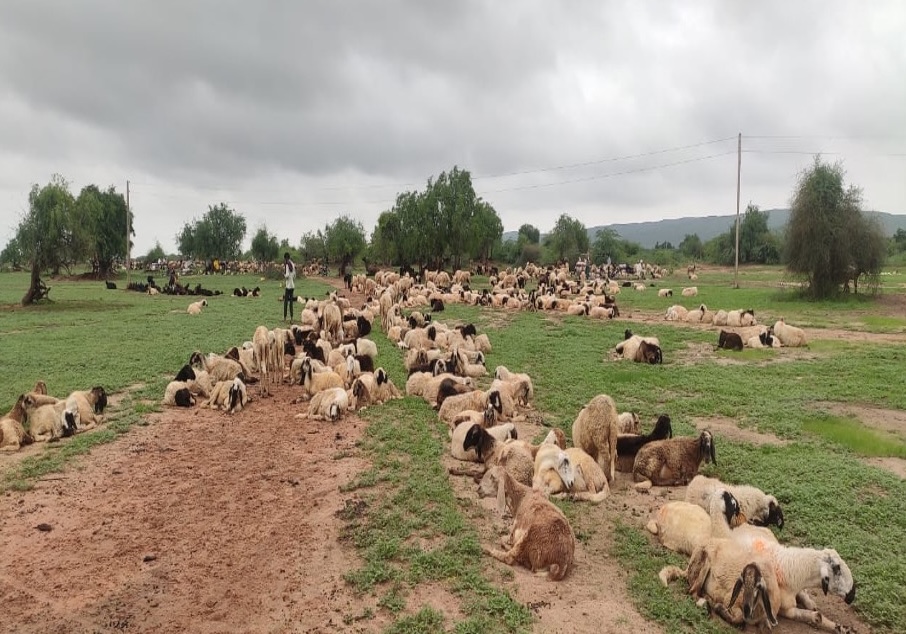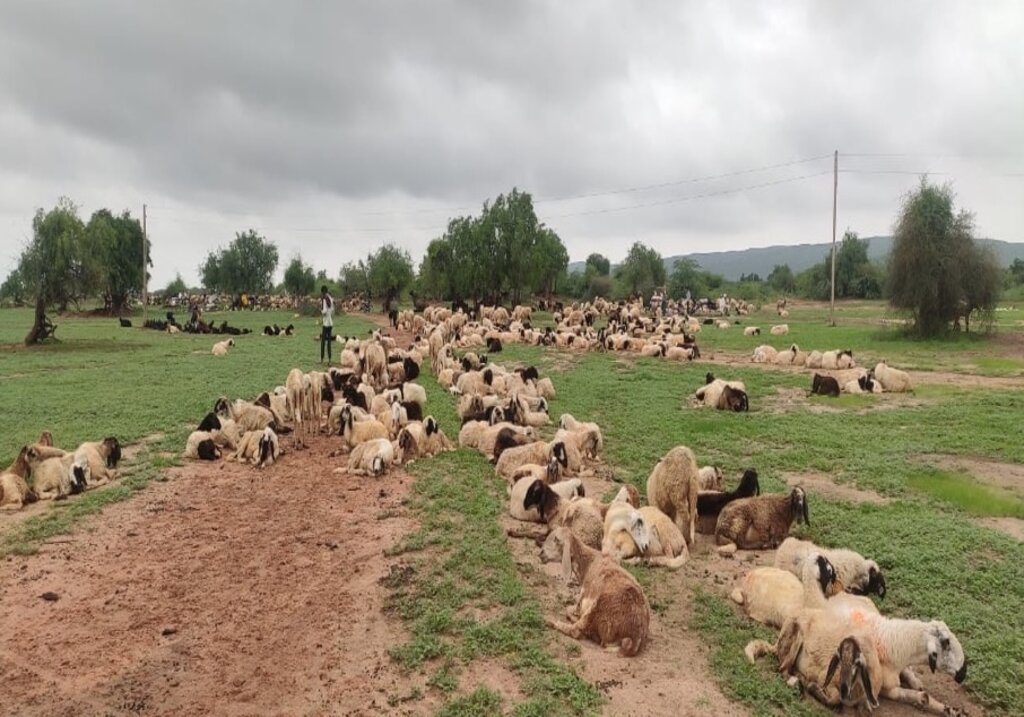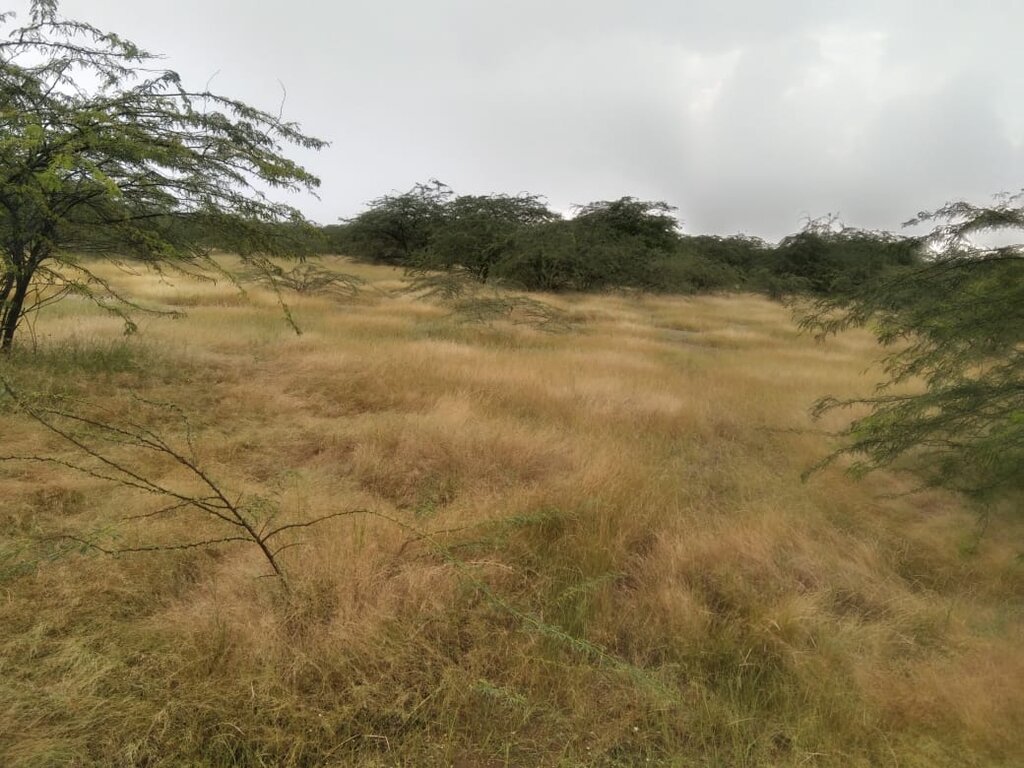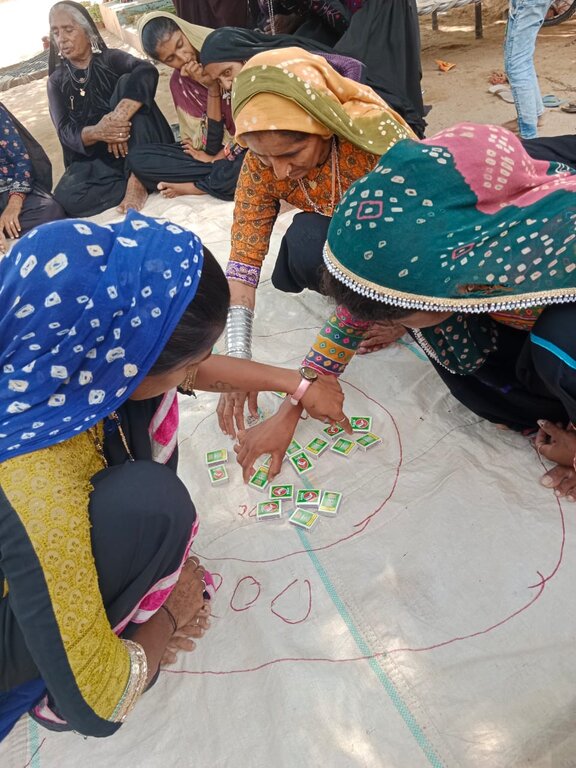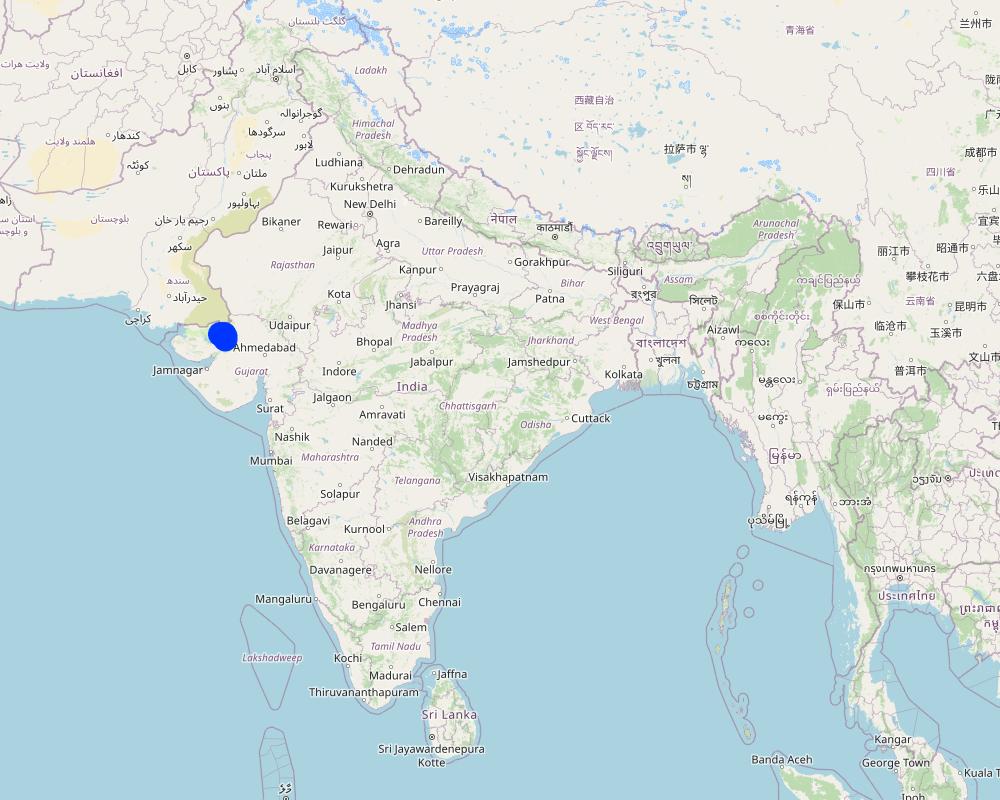TRANSFORMING VILLAGE WASTELAND INTO A RICH PASTURE [India]
- Creation:
- Update:
- Compiler: Bhavana Rabari
- Editor: –
- Reviewer: Udo Höggel
Jamin Sudharana
technologies_7423 - India
View sections
Expand all Collapse all1. General information
1.2 Contact details of resource persons and institutions involved in the assessment and documentation of the Technology
Key resource person(s)
Project Co-ordinator:
Desai Bhavana
Maldhari Rural Action Group
India
Communication Officer:
Sheth Megha
MARAG - Maldhari Rural Action Group
India
Name of the institution(s) which facilitated the documentation/ evaluation of the Technology (if relevant)
Maldhari Rural Action Group (MARAG)1.3 Conditions regarding the use of data documented through WOCAT
The compiler and key resource person(s) accept the conditions regarding the use of data documented through WOCAT:
Ja
1.4 Declaration on sustainability of the described Technology
Is the Technology described here problematic with regard to land degradation, so that it cannot be declared a sustainable land management technology?
Nee
2. Description of the SLM Technology
2.1 Short description of the Technology
Definition of the Technology:
Under the leadership of the Pastoralist Women Land Management Committee at village level, 100 acers of village wasteland were transformed into a rich pastures to be used by village livestock herds and, in this way providing food and livelihood security to local communities and restoring biodiversity within native grasses and indigenous livestock breeds.
2.2 Detailed description of the Technology
Description:
Overview
The initial project focused on 10 villages within Kutch District, Gujarat, Western India. Each of these villages developed 10 acres of associated common pastureland. In total, 100 acres were developed. The project offered local solutions to develop village wastelands (common term in India for degraded lands) into ecologically regenerated pasturelands. Village pastureland, developed in such manner was used for open and free grazing for livestock. This enhanced milk production thus generating income for village women and their families.
Process
MARAG formed a WPLMC (Women’s Pastureland Management Committee) in each village consisting of 10 members. Each WPLMC managed 10 acres of these common pasturelands in their respective villages. WPLMCs were trained and engaged in land mapping and demarcation through GPS, soil testing, land cleaning and land levelling, selection of native grass seeds, sowing of such grasses, and general maintenance and management of the land.
The rules and regulations for land management were determined by the WPLMCs. WPLMCs jointly decided to use 5 of 10 acres of each village gaucher (local term for pasture) to develop traditional grasses for small ruminants. Out of this, 2.5 acres were developed as fodder for large livestock and 2.5 acres were developed for drought tolerant species. Finally, the WPLMCs documented the regulation and use of pastureland and the responsibility of the management.
The following processes were employed for pastureland regeneration:
1.Silvipasture practice
2.Land treatment and afforestation
3.Reintroduction of traditional grass seeds.
4.Tapping of indigenous pastoral knowledge for grass development and breed conservation.
5.Forming and strengthening Women Pastureland Management Committees (WPLMC) at village level for project sustainability.
6.Using technology and capacity building of the WPLMC (e.g. GPS tools for land measuring, mobile app use for determining land fertility and water catchment etc.)
Livestock rearing can be a tool for the sustainable management of land, especially in arid and semiarid areas, by improving soil health, mitigating desertification and protecting the local ecosystem against invasive species. Sustanable livestock grazing breaks soil crust, increasing rain water absorpstion and converts grass into organic waste, increasing soil health and regenarating grasses by spreading seed.
Project Impact
1.Developed women leadership and management capacities as well as decision making throughout the project process.
2.Ownership of the pastureland development taken by pastoralist women.
3.Pastoralist women learning and using the smartphone for land mapping. Such knowledge is easily copied by other women in the village.
4.Traditional knowledge on pasture grasses women to deepen their knowledge on pasture management.
5.Biodiversity conservation through traditional knowledge.
6.Secured livelihood security and food sovereignty.
2.3 Photos of the Technology
2.4 Videos of the Technology
Name of videographer:
Bhavana Rabari
2.5 Country/ region/ locations where the Technology has been applied and which are covered by this assessment
Country:
India
Region/ State/ Province:
Gujarat
Further specification of location:
Dhabda village of Kutch District
Specify the spread of the Technology:
- applied at specific points/ concentrated on a small area
Is/are the technology site(s) located in a permanently protected area?
Nee
Map
×2.6 Date of implementation
Indicate year of implementation:
2022
2.7 Introduction of the Technology
Specify how the Technology was introduced:
- as part of a traditional system (> 50 years)
Comments (type of project, etc.):
It is rooted in traditional practices but now incorporates technology. Pastoralists use smartphones to map grazing lands, identify water catchment areas, and determine more fertile land.
3. Classification of the SLM Technology
3.1 Main purpose(s) of the Technology
- reduce, prevent, restore land degradation
- conserve ecosystem
- preserve/ improve biodiversity
- create beneficial economic impact
- create beneficial social impact
3.2 Current land use type(s) where the Technology is applied
Land use mixed within the same land unit:
Ja
Specify mixed land use (crops/ grazing/ trees):
- Silvo-pastoralism
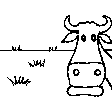
Grazing land
Extensive grazing:
- Semi-nomadic pastoralism
Intensive grazing/ fodder production:
- Improved pastures
Animal type:
- buffalo
- cattle - dairy
- goats
- sheep
Is integrated crop-livestock management practiced?
Nee
Products and services:
- economic security, investment prestige
- milk
- whool
Species:
buffalo
Species:
cattle - dairy
Species:
goats
Species:
sheep
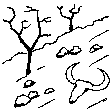
Unproductive land
Specify:
Village wasteland
3.3 Has land use changed due to the implementation of the Technology?
Has land use changed due to the implementation of the Technology?
- No (Continue with question 3.4)
3.4 Water supply
Water supply for the land on which the Technology is applied:
- rainfed
3.5 SLM group to which the Technology belongs
- pastoralism and grazing land management
- improved ground/ vegetation cover
- ground water management
3.6 SLM measures comprising the Technology
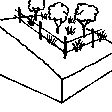
management measures
- M2: Change of management/ intensity level
- M3: Layout according to natural and human environment
- M5: Control/ change of species composition
3.7 Main types of land degradation addressed by the Technology

soil erosion by wind
- Et: loss of topsoil

biological degradation
- Bc: reduction of vegetation cover
- Bh: loss of habitats
- Bq: quantity/ biomass decline
- Bs: quality and species composition/ diversity decline
3.8 Prevention, reduction, or restoration of land degradation
Specify the goal of the Technology with regard to land degradation:
- prevent land degradation
- restore/ rehabilitate severely degraded land
4. Technical specifications, implementation activities, inputs, and costs
4.1 Technical drawing of the Technology
Technical specifications (related to technical drawing):
Four squares of pastureland from a total of 10 acres pastureland per village, mainly at the same altitude without any slope were developed. Trees and cultivating native and indigenous grasses species with women's traditional knowledge were in focus.
Author:
MARAG - Maldhari Rural Action Group (Community)
Date:
01/08/2024
4.2 General information regarding the calculation of inputs and costs
Specify how costs and inputs were calculated:
- per Technology area
Indicate size and area unit:
10 acres
If using a local area unit, indicate conversion factor to one hectare (e.g. 1 ha = 2.47 acres): 1 ha =:
1 hectare = 2,47 acres
other/ national currency (specify):
INR
If relevant, indicate exchange rate from USD to local currency (e.g. 1 USD = 79.9 Brazilian Real): 1 USD =:
84.35
Indicate average wage cost of hired labour per day:
250
4.3 Establishment activities
| Activity | Timing (season) | |
|---|---|---|
| 1. | Organising pastoral women management committee | September - October |
| 2. | Capacity building of committee on SLM technologies | December, year 1 |
| 3. | User rights for the village wasteland under WPLMC from revenue department | November - December year 1 |
| 4. | Removal of invasive species | January- February |
| 5. | Land leveling | March - Before Monsoon |
| 6. | Pasture border trenches | April - Before Monsoon |
| 7. | Sowing of grasses and tree planting | July - August |
| 8. | Rain-fed irrigation | Throughout Monsoon (June to October) |
| 9. | Protection from wild animals | April - December year 1 |
| 10. | Livestock grazing | August till grass ends |
| 11. | Fodder harvesting | November - March |
| 12. | Establishing and implementation of pastureland user and management rights | December year 1, December year 2 |
4.4 Costs and inputs needed for establishment
| Specify input | Unit | Quantity | Costs per Unit | Total costs per input | % of costs borne by land users | |
|---|---|---|---|---|---|---|
| Labour | GPS - mapping | Person-Day | 2.0 | 500.0 | 1000.0 | |
| Labour | Land leveling and preparation | Person | 15.0 | 550.0 | 8250.0 | 25.0 |
| Labour | Seed sowing | Person | 3.0 | 700.0 | 2100.0 | 100.0 |
| Labour | Tree plantation | Person | 12.0 | 300.0 | 3600.0 | 100.0 |
| Labour | Pastureland security guard | Person | 6.0 | 500.0 | 3000.0 | 50.0 |
| Labour | Fodder harvest | Person | 10.0 | 200.0 | 2000.0 | 40.0 |
| Equipment | Smart Phone | Piece | 1.0 | 14000.0 | 14000.0 | 100.0 |
| Equipment | JCB (backhoe tractor for land levelling) | per Hour | 12.0 | 900.0 | 10800.0 | |
| Equipment | Tractor | Per Hour | 25.0 | 700.0 | 17500.0 | |
| Equipment | Tree Guard | Piece | 17.0 | 550.0 | 9350.0 | 30.0 |
| Equipment | Fencing Material | Kg | 50.0 | 70.0 | 3500.0 | |
| Equipment | Farming tools | Piece | 6.0 | 350.0 | 2100.0 | 50.0 |
| Plant material | Grass seeds | Kg | 400.0 | 50.0 | 20000.0 | 30.0 |
| Plant material | Tree saplings | No of plants | 125.0 | 50.0 | 6250.0 | 100.0 |
| Fertilizers and biocides | Manure | No of Trolly | 3.0 | 1500.0 | 4500.0 | 100.0 |
| Fertilizers and biocides | Biofertilizer | No of Trolly | 2.0 | 1500.0 | 3000.0 | 100.0 |
| Total costs for establishment of the Technology | 110950.0 | |||||
| Total costs for establishment of the Technology in USD | 1315.35 | |||||
If land user bore less than 100% of costs, indicate who covered the remaining costs:
Project and other volunteers
Comments:
In some cases where women contributed 100%, such amount was often contributed by in-kind work or by labourforce.
4.5 Maintenance/ recurrent activities
| Activity | Timing/ frequency | |
|---|---|---|
| 1. | Trench repairing | April - pre monsoon |
| 2. | Removal of invasive spices | May - pre monsoon |
| 3. | Seed sowing | July - onset monsoon |
| 4. | Irrigation in extreme cases | Winter - Summer |
| 5. | Harvesting | Post monsoon |
4.6 Costs and inputs needed for maintenance/ recurrent activities (per year)
| Specify input | Unit | Quantity | Costs per Unit | Total costs per input | % of costs borne by land users | |
|---|---|---|---|---|---|---|
| Labour | Trench repairing | per person | 7.0 | 500.0 | 3500.0 | 100.0 |
| Labour | Removal of invasive species | per person | 10.0 | 550.0 | 5500.0 | 100.0 |
| Labour | Seed sowing | per person | 3.0 | 700.0 | 2100.0 | 100.0 |
| Labour | Irrigation | per person | 3.0 | 350.0 | 1050.0 | 100.0 |
| Labour | Harvest | per person | 10.0 | 200.0 | 2000.0 | 100.0 |
| Equipment | Water charges (watering tree saplings) | No of tanks | 7.0 | 1200.0 | 8400.0 | |
| Plant material | Seed ( fodder seeds, e.g. sorghum species) | kg | 400.0 | 50.0 | 20000.0 | |
| Plant material | Tree saplings | no of plants | 20.0 | 50.0 | 1000.0 | 100.0 |
| Fertilizers and biocides | Manure | per trolly | 3.0 | 1500.0 | 4500.0 | 100.0 |
| Fertilizers and biocides | Bio fertilizer | per trolly | 2.0 | 1500.0 | 3000.0 | 100.0 |
| Other | Soil testing | per test | 1.0 | 1000.0 | 1000.0 | 100.0 |
| Total costs for maintenance of the Technology | 52050.0 | |||||
| Total costs for maintenance of the Technology in USD | 617.07 | |||||
If land user bore less than 100% of costs, indicate who covered the remaining costs:
The management committee covered the remaining costs using earnings from the previous year's fodder cultivation thus ensuring sustainability for the next cycle.
4.7 Most important factors affecting the costs
Describe the most determinate factors affecting the costs:
Climate uncertainty, availability of land under the Revenue Office, irregular rains.
5. Natural and human environment
5.1 Climate
Annual rainfall
- < 250 mm
- 251-500 mm
- 501-750 mm
- 751-1,000 mm
- 1,001-1,500 mm
- 1,501-2,000 mm
- 2,001-3,000 mm
- 3,001-4,000 mm
- > 4,000 mm
Specify average annual rainfall (if known), in mm:
410.00
Specifications/ comments on rainfall:
Historically arid and semi-arid region.
Indicate the name of the reference meteorological station considered:
Bhuj - Weather Station
Agro-climatic zone
- semi-arid
Over 40°C in the summer and averaging around 20°C in the winter, 30°C during monsoon.
5.2 Topography
Slopes on average:
- flat (0-2%)
- gentle (3-5%)
- moderate (6-10%)
- rolling (11-15%)
- hilly (16-30%)
- steep (31-60%)
- very steep (>60%)
Landforms:
- plateau/plains
- ridges
- mountain slopes
- hill slopes
- footslopes
- valley floors
Altitudinal zone:
- 0-100 m a.s.l.
- 101-500 m a.s.l.
- 501-1,000 m a.s.l.
- 1,001-1,500 m a.s.l.
- 1,501-2,000 m a.s.l.
- 2,001-2,500 m a.s.l.
- 2,501-3,000 m a.s.l.
- 3,001-4,000 m a.s.l.
- > 4,000 m a.s.l.
Indicate if the Technology is specifically applied in:
- not relevant
5.3 Soils
Soil depth on average:
- very shallow (0-20 cm)
- shallow (21-50 cm)
- moderately deep (51-80 cm)
- deep (81-120 cm)
- very deep (> 120 cm)
Soil texture (topsoil):
- coarse/ light (sandy)
Soil texture (> 20 cm below surface):
- fine/ heavy (clay)
Topsoil organic matter:
- low (<1%)
5.4 Water availability and quality
Ground water table:
> 50 m
Availability of surface water:
poor/ none
Water quality (untreated):
for agricultural use only (irrigation)
Water quality refers to:
ground water
Is water salinity a problem?
Ja
Is flooding of the area occurring?
Nee
5.5 Biodiversity
Species diversity:
- low
Habitat diversity:
- low
Comments and further specifications on biodiversity:
Before 40 years, the region was rich in biodiversity. Yet, considering modern challenges like industrialisation, migration, land encroachment, climate change and desertification, this biodiversity is in danger.
5.6 Characteristics of land users applying the Technology
Sedentary or nomadic:
- Semi-nomadic
Market orientation of production system:
- mixed (subsistence/ commercial)
Off-farm income:
- less than 10% of all income
Relative level of wealth:
- poor
Individuals or groups:
- groups/ community
Level of mechanization:
- manual work
Gender:
- women
Age of land users:
- youth
- middle-aged
5.7 Average area of land used by land users applying the Technology
- < 0.5 ha
- 0.5-1 ha
- 1-2 ha
- 2-5 ha
- 5-15 ha
- 15-50 ha
- 50-100 ha
- 100-500 ha
- 500-1,000 ha
- 1,000-10,000 ha
- > 10,000 ha
Is this considered small-, medium- or large-scale (referring to local context)?
- medium-scale
5.8 Land ownership, land use rights, and water use rights
Land ownership:
- state
Land use rights:
- communal (organized)
Water use rights:
- open access (unorganized)
Are land use rights based on a traditional legal system?
Ja
5.9 Access to services and infrastructure
health:
- poor
- moderate
- good
education:
- poor
- moderate
- good
technical assistance:
- poor
- moderate
- good
employment (e.g. off-farm):
- poor
- moderate
- good
markets:
- poor
- moderate
- good
energy:
- poor
- moderate
- good
roads and transport:
- poor
- moderate
- good
drinking water and sanitation:
- poor
- moderate
- good
financial services:
- poor
- moderate
- good
6. Impacts and concluding statements
6.1 On-site impacts the Technology has shown
Socio-economic impacts
Production
fodder production
Quantity before SLM:
0
Quantity after SLM:
10%
fodder quality
Comments/ specify:
Cultivation of indigenous fodder lead to qualitative fodder for livestock.
land management
Quantity after SLM:
75%
Comments/ specify:
Priorly Wasteland was not managed at all. With the onset of the project , land is now managed and yields results for the people who live from the land. In this way land management is simplified and productive.
Socio-cultural impacts
food security/ self-sufficiency
Comments/ specify:
Food sovereignty of livestock improved.
Traditional knowledge conservation
Comments/ specify:
The process of transforming wasteland to rich pasture by the community led to reviving as well as improving traditional knowledge of grass- and breed management and conservation.
Ecological impacts
Biodiversity: vegetation, animals
Vegetation cover
plant diversity
Comments/ specify:
Indigenous plants survive under extreme climatic conditions.
6.2 Off-site impacts the Technology has shown
Specify assessment of off-site impacts (measurements):
Restored pastureland cater to livestock from the site as well as off site community. Helps the migrating pastoralist as well.
6.3 Exposure and sensitivity of the Technology to gradual climate change and climate-related extremes/ disasters (as perceived by land users)
Gradual climate change
Gradual climate change
| Season | increase or decrease | How does the Technology cope with it? | |
|---|---|---|---|
| annual temperature | increase | moderately | |
| seasonal temperature | summer | increase | moderately |
| annual rainfall | increase | moderately | |
| seasonal rainfall | wet/ rainy season | increase | moderately |
Climate-related extremes (disasters)
Meteorological disasters
| How does the Technology cope with it? | |
|---|---|
| local rainstorm | moderately |
Climatological disasters
| How does the Technology cope with it? | |
|---|---|
| drought | well |
6.4 Cost-benefit analysis
How do the benefits compare with the establishment costs (from land users’ perspective)?
Short-term returns:
positive
Long-term returns:
very positive
How do the benefits compare with the maintenance/ recurrent costs (from land users' perspective)?
Short-term returns:
positive
Long-term returns:
very positive
6.5 Adoption of the Technology
- > 50%
If available, quantify (no. of households and/ or area covered):
Almost 70% of the households constitute pastoralist communities and are included in the process implementation.
Of all those who have adopted the Technology, how many did so spontaneously, i.e. without receiving any material incentives/ payments?
- 0-10%
Comments:
As the process required technical and legal support other than technology support and payments.
6.6 Adaptation
Has the Technology been modified recently to adapt to changing conditions?
Nee
6.7 Strengths/ advantages/ opportunities of the Technology
| Strengths/ advantages/ opportunities in the land user’s view |
|---|
| Community women led the transformative processes. The communities also learnt technical aspects and mixed these with traditional knowledge withstanding climate change impacts. Communities also availed collective user rights on the village wasteland. |
| Strengthening age-old livelihood security mechanisms and ways of communal life. |
| Recognition of communities' roles and responsibilities as land governance actors and managers of future sustainabilities. |
| Strengths/ advantages/ opportunities in the compiler’s or other key resource person’s view |
|---|
| First ever community women led land-transformation and restoration model. |
| Climate change resilient, community led practice. |
| Documentation and preservation of traditional knowledge. |
6.8 Weaknesses/ disadvantages/ risks of the Technology and ways of overcoming them
| Weaknesses/ disadvantages/ risks in the land user’s view | How can they be overcome? |
|---|---|
| Promoting sedentary lifestyles. | |
| Conflict with other local communities due to land issues. | Conflict resolution mechanisms. |
| Weaknesses/ disadvantages/ risks in the compiler’s or other key resource person’s view | How can they be overcome? |
|---|---|
| Only women are involved while men restrict their roles and responsibilities. | |
| The Revenue Department can restrict the use rights of community lands at any time. | Policy advocacy for communities' land rights, social awareness. |
7. References and links
7.1 Methods/ sources of information
- field visits, field surveys
4 villages out of 10.
- interviews with land users
4 women leaders from WPLMC.
- compilation from reports and other existing documentation
FInal reports and presentations presented at different platforms.
When were the data compiled (in the field)?
30/09/2024
7.2 References to available publications
Title, author, year, ISBN:
Meri Mitti report by Marag, 2022
Available from where? Costs?
MARAG NGO (see website)
7.3 Links to relevant online information
Title/ description:
Innovative and effective women-led solutions for drought resilience and adaptation
URL:
https://www.unccd.int/sites/default/files/2024-10/20241005_women-led-DRAFT_V6.pdf
7.4 General comments
The questionnaire is well-designed, covering comprehensive information and effectively addressing all key aspects of Sustainable Land Management (SLM). It touches on each relevant area, ensuring thorough data collection.
Links and modules
Expand all Collapse allLinks
No links
Modules
No modules


